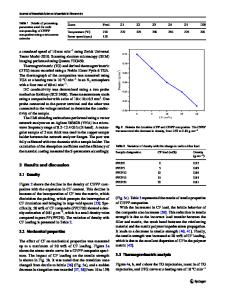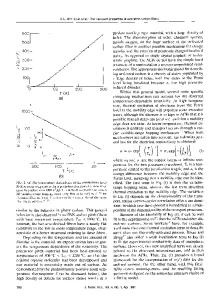Influence of chemically treated carbon fibers on the electromagnetic shielding of ultra-high-performance fiber-reinforce
- PDF / 3,345,444 Bytes
- 15 Pages / 595.276 x 790.866 pts Page_size
- 47 Downloads / 311 Views
(2020) 20:123
ORIGINAL ARTICLE
Influence of chemically treated carbon fibers on the electromagnetic shielding of ultra‑high‑performance fiber‑reinforced concrete Doo‑Yeol Yoo1 · Min‑Chang Kang1 · Hong‑Joon Choi1 · Wonsik Shin1 · Soonho Kim1 Received: 4 April 2020 / Revised: 25 August 2020 / Accepted: 7 September 2020 © Wroclaw University of Science and Technology 2020
Abstract The effects of carbon fiber and its surface treatment through chemical solutions on the mechanical properties and electromagnetic (EM) shielding of ultra-high-performance fiber-reinforced concrete (UHPFRC) were analyzed. Three types of carbon fibers chemically treated with sodium hydroxide, nitric acid, and ammonia solutions were evaluated, along with a plain carbon fiber control sample, at two different concentrations of 0.1% and 0.3% by weight. The surface of carbon fiber was oxidized by chemical solutions. The conductivity of UHPFRC increased with increasing the carbon fiber content, and slightly better conductivity was obtained using the chemically treated carbon fibers than plain fibers at the lower content of 0.1 wt%. Both steel and carbon fibers were effective at improving the shielding effectiveness of ultra-high-performance concrete, and a higher shielding effectiveness was achieved for higher carbon fiber content. Surface treatment using the nitric acid solution was the most effective at enhancing the tensile performance and EM shielding effectiveness, and the best shielding effectiveness (49.0 dB at 1 GHz) was achieved for UHPFRC with 0.1 wt% nitric acid treated carbon fibers. The shielding effectiveness was found to be generally proportional to the electrical conductivity, although its increase was minor relative to that of the conductivity.
* Doo‑Yeol Yoo [email protected] Min‑Chang Kang [email protected] Hong‑Joon Choi [email protected] Wonsik Shin [email protected] Soonho Kim [email protected] 1
Department of Architectural Engineering, Hanyang University, 222 Wangsimni‑ro, Seongdong‑gu, Seoul 04763, Republic of Korea
13
Vol.:(0123456789)
123
Page 2 of 15
Archives of Civil and Mechanical Engineering
(2020) 20:123
Graphic abstract
50 40 30 20
0
n-C
Control p-C0.1 p-C0.3
10 600
900
1200
1500
60 50 40 30 20
0
1800
Control a-C0.1 a-C0.3
10 600
900
Frequency (MHz)
50 40 30 20
Control s-C0.1 s-C0.3
10 0
600
900
1200
1500
Frequency (MHz)
C
2 μm
O
2 μm
Na
2 μm
C
2 μm
O
2 μm
Na
2 μm
s-C
C
2 μm
O
2 μm
Na
2 μm
n-C
Shielding effectiveness (dB)
a-C
2 μm
O
2 μm
Na
2 μm
1800
1800
60 50 40 30 20
Control n-C0.1 n-C0.3
10 0
600
900
1200
1500
1800
Frequency (MHz)
50
50
40
40
30
30
20
20
10 0
C
1500
70
60
Shielding effectiveness (dB)
Shielding effectiveness (dB)
70
p-C
1200
Frequency (MHz)
0.1 wt.% 0.3 wt.% Control
Plain
Aqueous Sodium Nitric acid ammonia hydroxide
10
Shielding effectiveness (dB)
s-C
70
60
Shielding effectiveness (dB)
70
a-C
Shielding effectiveness (dB)
p-C
0
Keywords Ultra-high-performance fi
Data Loading...











